AUDI R8 SPYDER 2011 Owners Manual
Manufacturer: AUDI, Model Year: 2011, Model line: R8 SPYDER, Model: AUDI R8 SPYDER 2011Pages: 244, PDF Size: 59.74 MB
Page 191 of 244
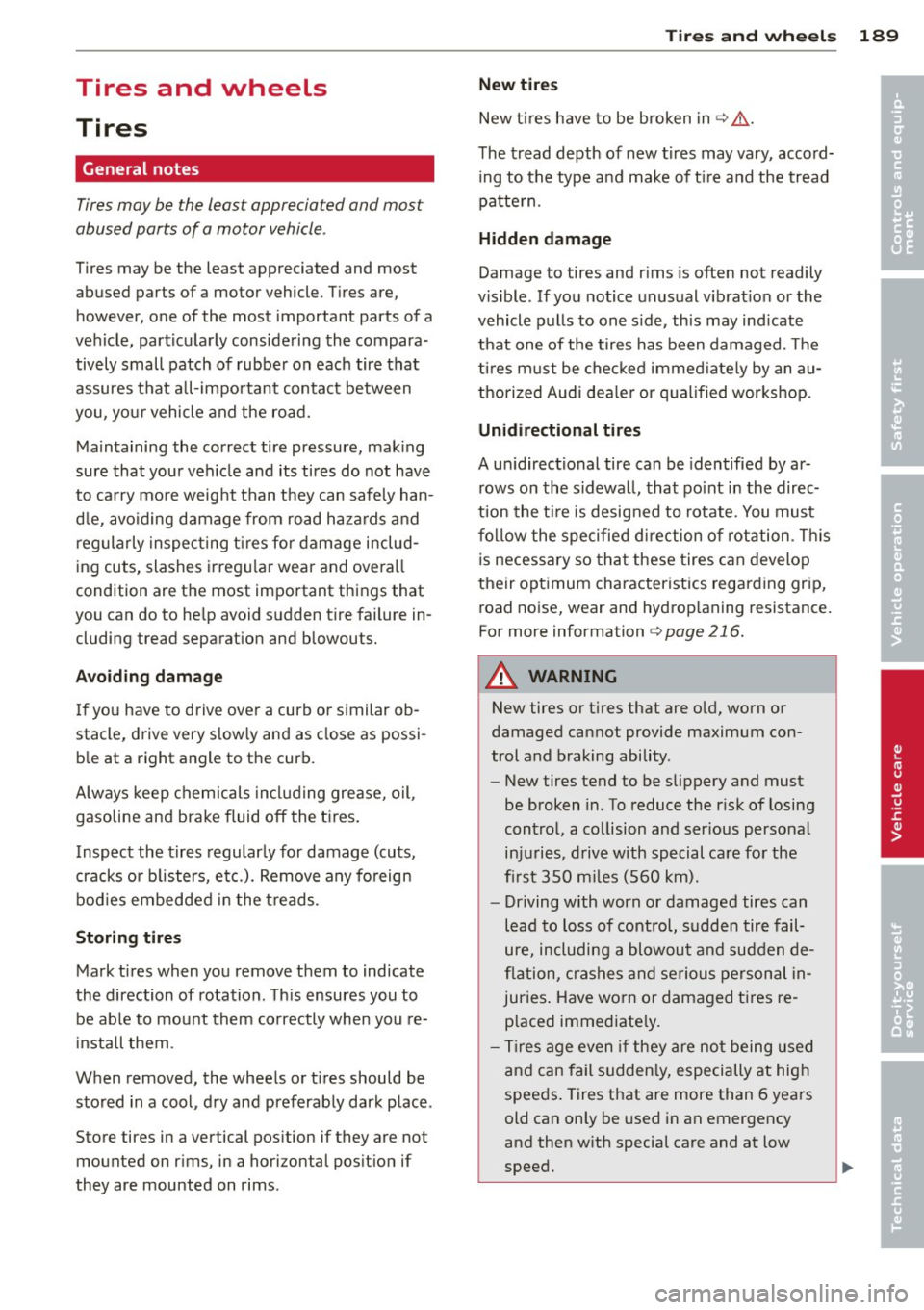
Tires and wheels
Tires
General notes
Tires may be the least appreciated and most
abused parts of a motor vehicle .
Tires may be the least appreciated and most
abused parts of a motor vehicle . T ires are,
however, one of the most important parts of a
vehicle, particularly considering the compara
tively small patch of rubber on each tire that
assures that a ll- important contact between
you, you r vehicle and the road.
Maintaining the correct tire pressure, mak ing
sure that your vehicle and its tires do not have
to carry mo re weight than they can safely han
d le, avoiding damage from road hazards and
r eg ularly inspect ing t ires for damage i nclud
ing cuts, slashes irregu la r wear and ove rall
condition are the most important things that
you can do to he lp avoid s udden tire failure in
cluding tread separat ion and blowouts.
A voidin g damage
If yo u have to d rive over a curb or similar ob
stacle, drive very slow ly and as close as possi
b le at a right angle to the curb.
A lways keep chemicals incl ud ing grease, o il ,
gasoline and brake fluid off the t ires .
I nspect the t ires regularly for damage (cuts,
cracks or b listers, etc.). Remove any fo reign
bod ies embedde d in the treads.
Storing tires Mark tires when you remove them to indicate
the direction of rotation . T his ensures you to
be ab le to mount them correctly when you re
i nstall them .
When removed, the whee ls or t ires should be
sto red in a cool, d ry and preferably dark place .
Store tires in a vertical pos ition if they are not
mounted on r ims, in a horizontal pos it ion if
they are mounted on rims .
Tires an d wheel s 189
New tires
New ti res h ave to be broken in~& .
The tread depth of new t ires may vary, accord
ing to the type a nd make of t ire and the tread
patte rn.
H idden damage
Damage to tires and r ims is ofte n not readily
visible . If you notice unusual v ib rat ion or the
vehicle pulls to one s ide, th is may ind icate
that one of the t ires has been damaged . T he
ti res m ust be chec ked immed iate ly by an au
thorized Audi dea le r or q ua lified wor kshop .
Unidirectional tires
A un idirectional tire can be identified by ar
rows on the sidewa ll, that po int in the direc
tion the t ire is designed to rotate. You must
f ol low the specified di rection o f rotation . T his
is necessary so that these tires can develop
their optimum characteristics regarding grip,
road noise, wear and hydrop laning resistance.
For more information
~ page 216.
A WARNING
New tires or t ires that are o ld, worn or
damaged cannot provide maximum con
trol and braking ability .
-
-New tires tend to be slippery and must
be broken in. To reduce the r isk of losing
control, a co llision and ser ious personal
in ju ries, d rive with special ca re for the
fi rst 350 m iles ( 560 km).
- Driving with worn or damaged tires can
lead to loss of control, sudden tire fail
ure, including a blowout and sudden de
fl ation, cras hes and se riou s personal in
juries . Have wo rn or damaged t ires re
placed immediate ly.
- Ti res age even if they are not being used
and can fail sudden ly, especially at hig h
speeds. Tires that are more than 6 years
old can only be used in an emergency
and then w ith special care and at low
speed.
•
•
Page 192 of 244
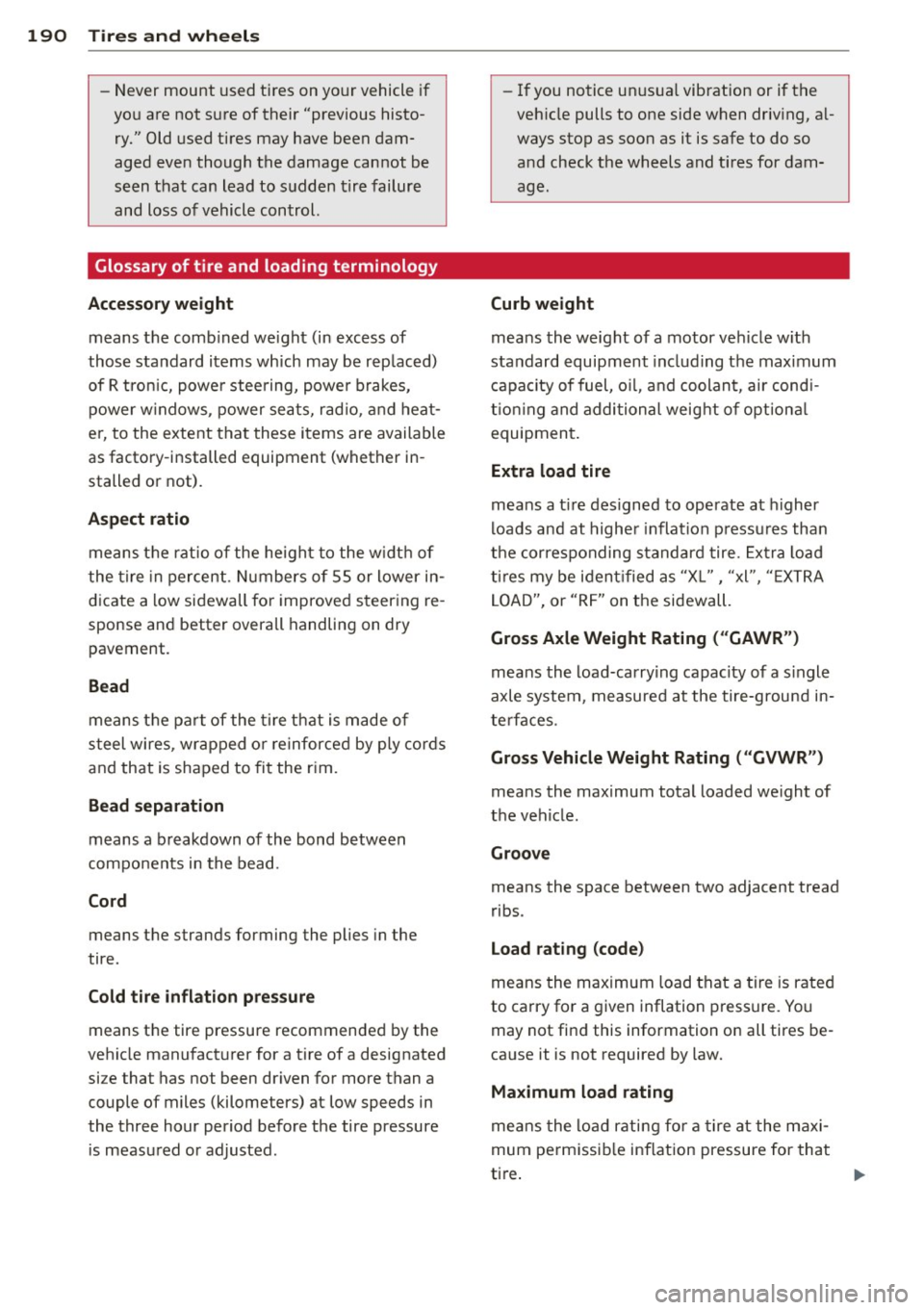
190 Tire s and wheel s
-Never mount used tires on yo ur vehicle if
yo u are not sure of their "previous histo
ry." Old used tires may have been dam
aged even though the damage cannot be
seen that can lead to sudden tire failure
and loss of vehicle control.
Glossary of tire and loading terminology
Accessory weight
means t he comb ined we ight (in excess of
those standard items which may be rep laced)
of R t ron ic, powe r stee ring, powe r brakes,
power w indows , power sea ts, r ad io , a nd hea t
e r, to the extent that these i tems are available
as facto ry -in stalled equipment (whether in
stalled or not).
Aspect ratio
means t he ratio o f the heigh t to the w idth of
the tire in percen t. Numbers of 55 or lower in
d icate a low sidewall fo r improved s teer ing re
sponse and better overall handling on dry
pavement.
Bead
means t he pa rt of the t ire that is made o f
steel wires, wrapped o r reinforce d by p ly cor ds
and that is shaped to fi t the r im.
Bead separation
means a b reakdown of the bond between
components in the bead.
Cord
means the s trands forming the plies in the
tire .
Cold tire inflation pre ssure
means t he tire pressure recommended by the
ve hicle manufacture r for a tire of a designated
si ze that has not been dr iven for more than a
couple of miles (kilometers) at low speeds in
the three hour period before the tire pressure i s measu red or adjusted. -
If you notice un usua l vibration or if the
veh icle pulls to one side when driv ing, a l
ways stop as soon as it is safe to do so and check the wheels and tires for dam
age.
Curb weight
means the we ight of a motor ve hicle w ith
standard equipment includ ing the max imum
capa city of fuel, o il, and coolant, a ir cond i
ti on ing and addi tional weig ht o f option al
equipmen t.
Extra load tire
means a tire designed to operate at higher
loads and at highe r inflat ion p ress ures tha n
the cor responding standard tire . Extr a load
t ir es my be i dent ified as "XL", "xl", "E X T RA
LO AD", or "RF" on t he sidewall.
Gross Axle Weight Rating ( "GAWR ")
means the load-carry ing capacity of a s ingle
axle system , measured at the tire-ground in
te rfaces .
Gross Vehicle Weight Rating ( "GVWR ")
means the maximum total loaded we ight of
the vehicle.
Groove
means the space between two adjacent tread
ribs .
Load rat ing (code )
means the maximum load that a tire is rated
to carry fo r a given inflation press ure. Yo u
may not fi nd this information on all tires be
ca use it is not required by law.
Maximum load rating
me ans the lo ad r ati ng for a tire a t the m axi
mum perm issib le inf lation pressure for that
ti re .
Page 193 of 244
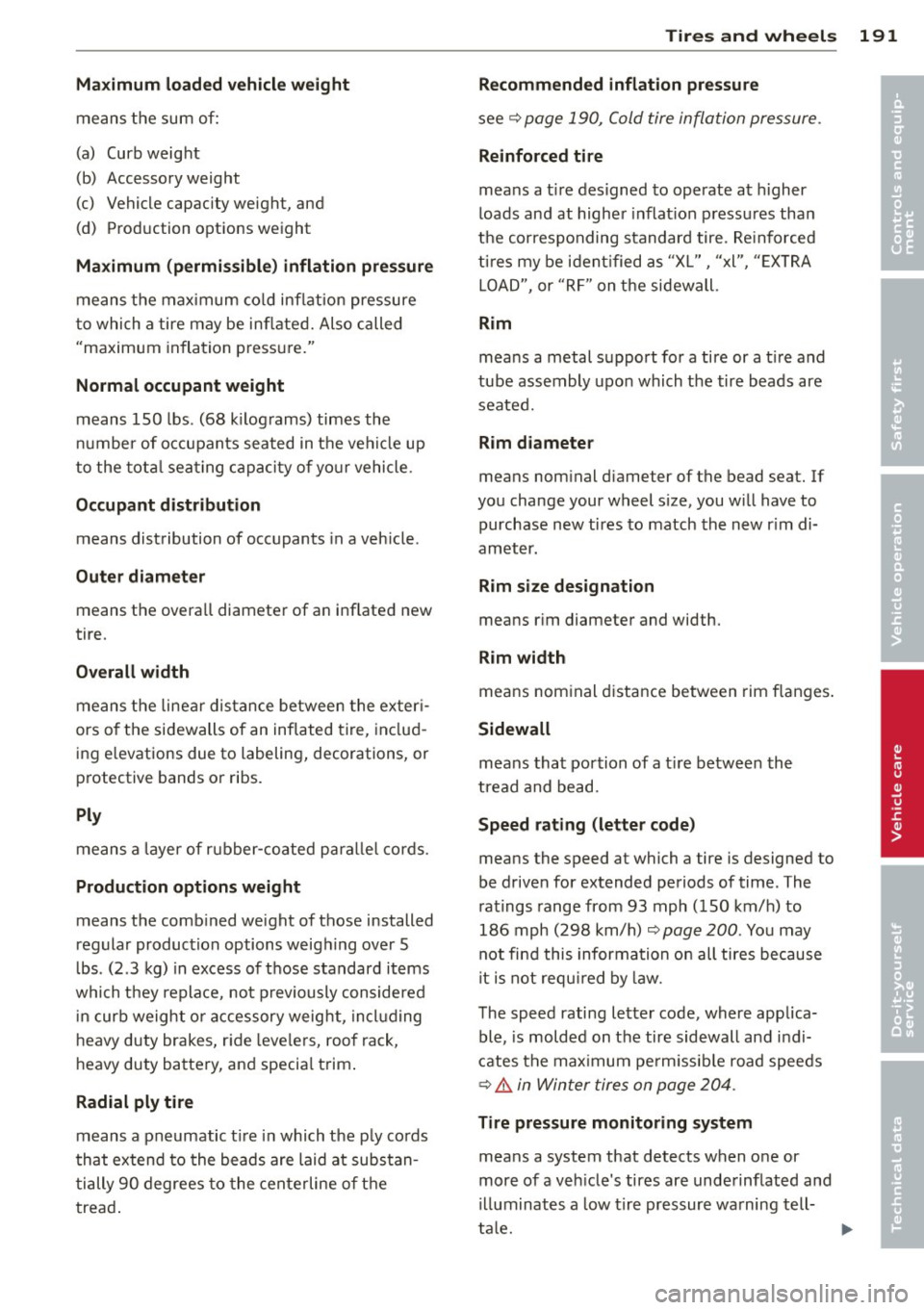
Maximum loaded vehicle weight
means the sum of:
(a) Curb weight
(b) Accessory weight
(c) Vehicle capacity weight, and
(d) Production options weight
Maximum (permissible) inflation pressure
means the maximum cold inflation pressure
to which a tire may be inflated. Also called
"maximum inflation pressu re."
Normal occupant weight
means 150 lbs. (68 k ilograms) times the
nu mber of occupants seated in the vehicle up
to the total seating capacity of your vehicle.
Occupant distribution
means distribution of occupants in a vehicle .
Outer diameter
means the overa ll diameter of an inflated new
tire.
Overall width
means the linear distance between the exteri
ors of the sidewalls of an inflated tire, includ
ing e levations due to labeling, decorations, or
protective bands or ribs.
Ply
means a layer of rubber-coated para llel cords.
Production options weight
means the comb ined weight of those installed
regular production options weighing over 5
lbs . (2 .3 kg) in excess of those standard items
which they replace, not previously considered
in curb weight or accessory weight, including
heavy duty brakes, r ide leve lers, roof rack,
heavy duty battery, and specia l trim .
Radial ply tire
means a pneumatic t ire in which the p ly cords
that extend to the beads are laid at substan
tially 90 degrees to the centerline of the
tread.
Tires and wheels 191
Recommended inflation pressure
see ~ page 190, Cold tire inflation pressure.
Reinforced tire
means a t ire designed to operate at higher
loads and at higher inflat ion pressures than
the corresponding standard tire. Re inforced
ti res my be ident ified as "XL" , "xl", "E XTRA
LOAD", or "RF" on the sidewall.
Rim
means a metal support for a tire or a tire and
tube assembly upon which the tire beads are
seated.
Rim diameter
means nom inal d iameter of the bead seat. If
you change your wheel s ize, you w ill have to
purchase new tires to match the new r im di
ameter.
Rim size designation
means r im diameter and width.
Rim width
means nom inal distance between rim fla nges.
Sidewall
means that portion of a tire between the
tread and bead.
Speed rating (letter code)
means the speed at which a tire is designed to
be driven for extended periods of time. The
ratings range from 93 mph (150 km/h) to
186 mph (298 km/h)
~ page 200 . You may
not find this information on all tires because
it is not requ ired by law.
T he speed rating letter code, where applica
ble, is molded on the tire sidewall and indi
cates the maximum pe rm issib le road speeds
~ .&. in Winter tires on page 204.
Tire pressure monitoring system
means a system that detects when one or
more of a veh icle's tires are underinflated and
illuminates a low tire pressure warning tell
tale.
•
•
Page 194 of 244
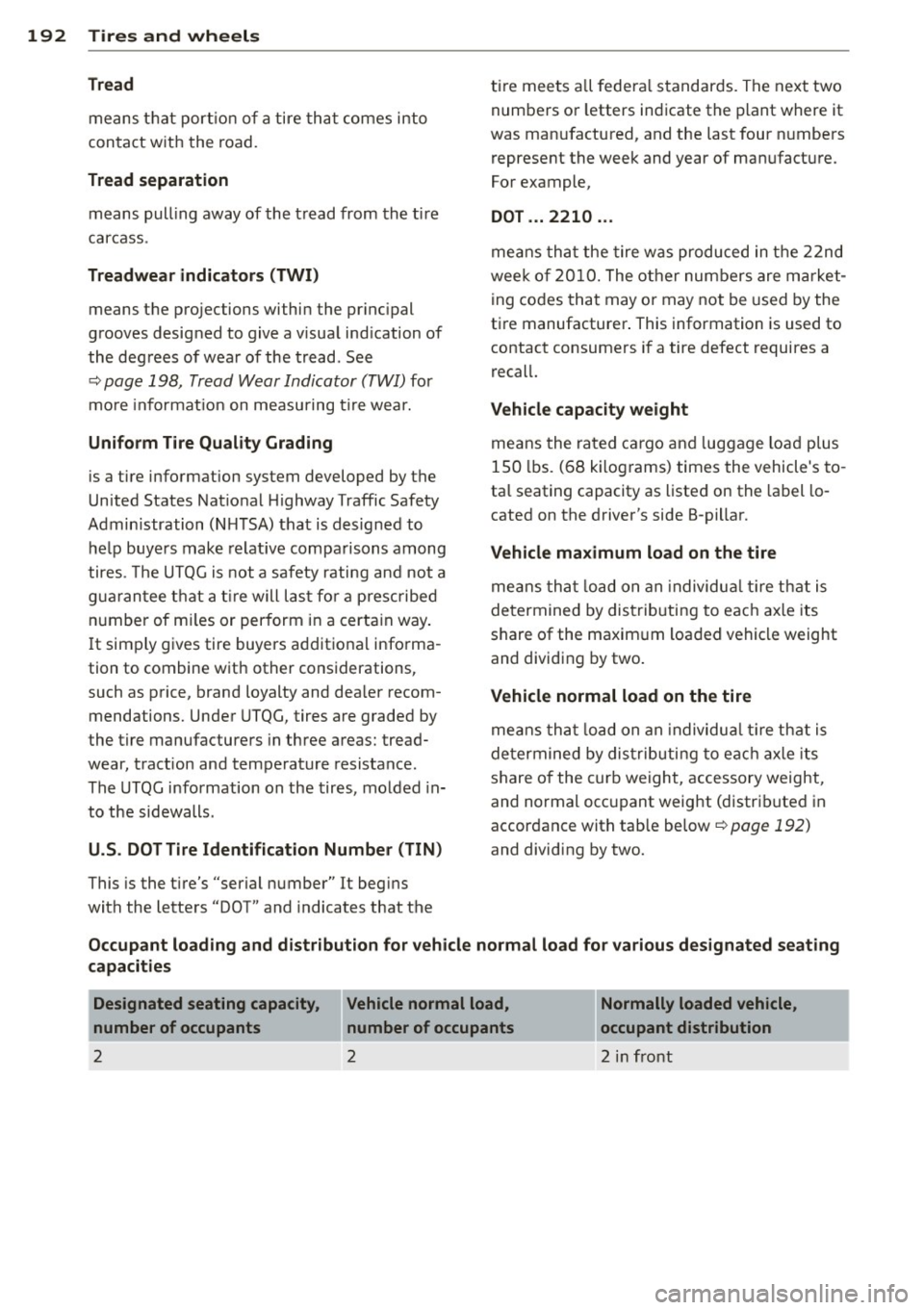
192 Tires and wheels
Tread
means that portion of a tire that comes into
contact with the road.
Tread separation
means pull ing away of the tread from the tire
carcass .
Treadwear indicators (TWI)
means the projections within the principal
grooves designed to give a v isual ind ication of
the degrees of wear of the tread. See
~ page 198, Tread Wear Indicator (TWI) for
more informat ion on measuring tire wear.
Uniform Tire Quality Grading
is a tire information system developed by the
United States National Highway Traffic Safety
Administration (NH TSA) that is designed to
help buyers make relative comparisons among
tires. The UTQG is not a safety rating and not a
guarantee that a tir e will last fo r a prescribed
number of miles or perform in a certain way.
It simply gives tire buyers additional informa
tion to combine w ith other considerations,
such as price, brand loyalty and dea ler recom
mendations. Under UTQG, tires are graded by
the tire manufacturers in three areas: tread
wear, tract ion and temperature resistance.
The UTQG information on the tires, molded in
to the sidewalls .
U.S. DOT Tire Identification Number (TIN)
This is the tire's "serial number" It begins
with the letters "DOT" and indicates that the tire meets a
ll federal standards. The next two
numbers or letters indicate the plant where it
was manufactured, and the last four numbers
represent the week and year of manufacture.
For example,
DOT . .. 2210 ...
means that the tire was produced in the 22nd
week of 2010. The other numbers are market
ing codes that may or may not be used by the
tire manufacturer . This information is used to
contact consumers if a tire defect requires a
recall.
Vehicle capacity weight
means the rated cargo and luggage load plus
150 lbs. (68 kilograms) times the vehicle's to
ta l seating capacity as listed on the label lo
cated on the driver's side B-pillar.
Vehicle maximum load on the tire
means that load on an individua l tire that is
determined by distributing to each axle its
share of the maximum loaded vehicle weight
and dividing by two.
Vehicle normal load on the tire
means that load on an individua l tire that is
determined by distributing to eac h axle its
share of the curb weight, accessory weight,
and normal occupant weight (distributed in
accordance with tab le below ~
page 192)
and dividing by two.
Occupant loading and distribution for vehicle normal load for various designated seating
capacities
I Designated seating capacity, Vehicle normal load,
number of occupants number of occupants
2 2
Normally loaded vehicle,
occupant distribution
•
2 in front
Page 195 of 244
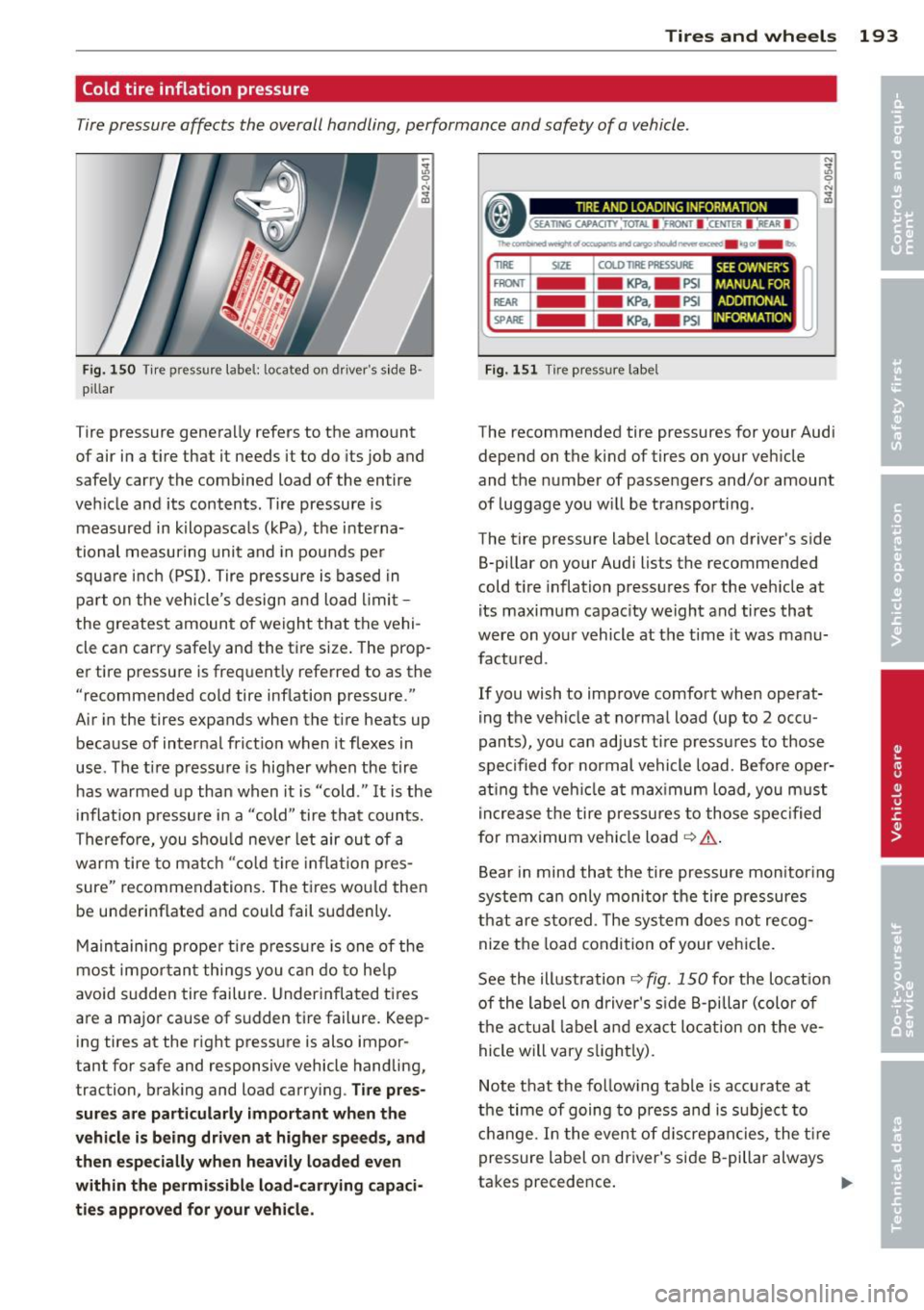
Tires and wheels 193
Cold tire inflation pressure
Tire pressure affects the overall handling, performance and safety of a vehicle.
Fig. 150 Tire pressure label: located on driver's side B·
pillar
Tire pressure generally refers to the amount
of air in a tire that it needs it to do its job and
safely carry the combined load of the entire
vehicle and its contents. Tire pressure is measured in kilopascals (kPa), the interna
tional measuring unit and in pounds per
square inch (PSI). Tire pressure is based in
part on the vehicle's design and load limit
the greatest amount of weight that the vehi
cle can carry safely and the tire size. The prop
er tire pressure is frequently referred to as the
"recommended cold tire inflation pressure."
Air in the tires expands when the tire heats up
because of internal friction when it flexes in
use. The tire pressure is higher when the tire
has warmed up than when it is "cold." It is the
inflation pressure in a "cold" tire that counts.
Therefore, you should never let air out of a
warm tire to match "cold tire inflation pres
sure" recommendations. The tires would then be underinflated and could fail suddenly.
Maintaining proper tire pressure is one of the
most important things you can do to help
avoid sudden tire failure. Underinflated tires
are a major cause of sudden tire failure. Keep
ing tires at the right pressure is also impor
tant for safe and responsive vehicle handling,
traction, braking and load carrying .
Tire pres
sures are particularly important when the
vehicle is being driven at higher speeds, and
then especially when heavily loaded even
within the permissible load-carrying capaci
ties approved for your vehicle.
"' ..,
-~ --------------- ~ a ;l!; TIRE AND LOADING INFORMATION
• (SfATING CAPAOTY JOTAI. I }ROHT I :CUITTR I :R£AR I)
l'hl!o combned~c:loo:upain.sanoatg0,sbo&AdnM'fexeeC1 •"'.gcw -b.
COI.O TIRE PRESSURE
- KPa.- PSI
- KPa,- PSI
_ KPa,. PSI
Fig. 151 Tire pressure label
SEE OWNER'S
MANUA L FOR
ADDITTONAL
INFOl
u
The recommended tire pressures for your Audi
depend on the kind of tires on your vehicle
and the number of passe ngers and/or amount
of luggage you will be transporting.
The tire pressure label located on driver's side
B-pillar on your Audi lists the recommended
cold tire inflation pressures for the vehicle at
its maximum capacity weight and tires that
were on your vehicle at the time it was manu
factured.
If you wish to improve comfort when operat
ing the vehicle at normal load (up to 2 occu
pants), you can adjust tire pressures to those
specified for normal vehicle load. Before oper
ating the vehicle at maximum load, you must
increase the tire pressures to those specified
for maximum vehicle load
9 .&.
Bear in mind that the tire pressure monitoring
system can only monitor the tire pressures
that are stored. The system does not recog
nize the load condition of your vehicle.
See the illustration,:;,
fig. 150 for the location
of the label on driver's side B-pillar (color of
the actual label and exact location on the ve
hicle will vary slightly).
Note that the following table is accurate at
the time of going to press and is subject to
change. In the event of discrepancies, the tire
pressure label on driver's side B-pillar always
ta kes precedence. ..,.
Page 196 of 244
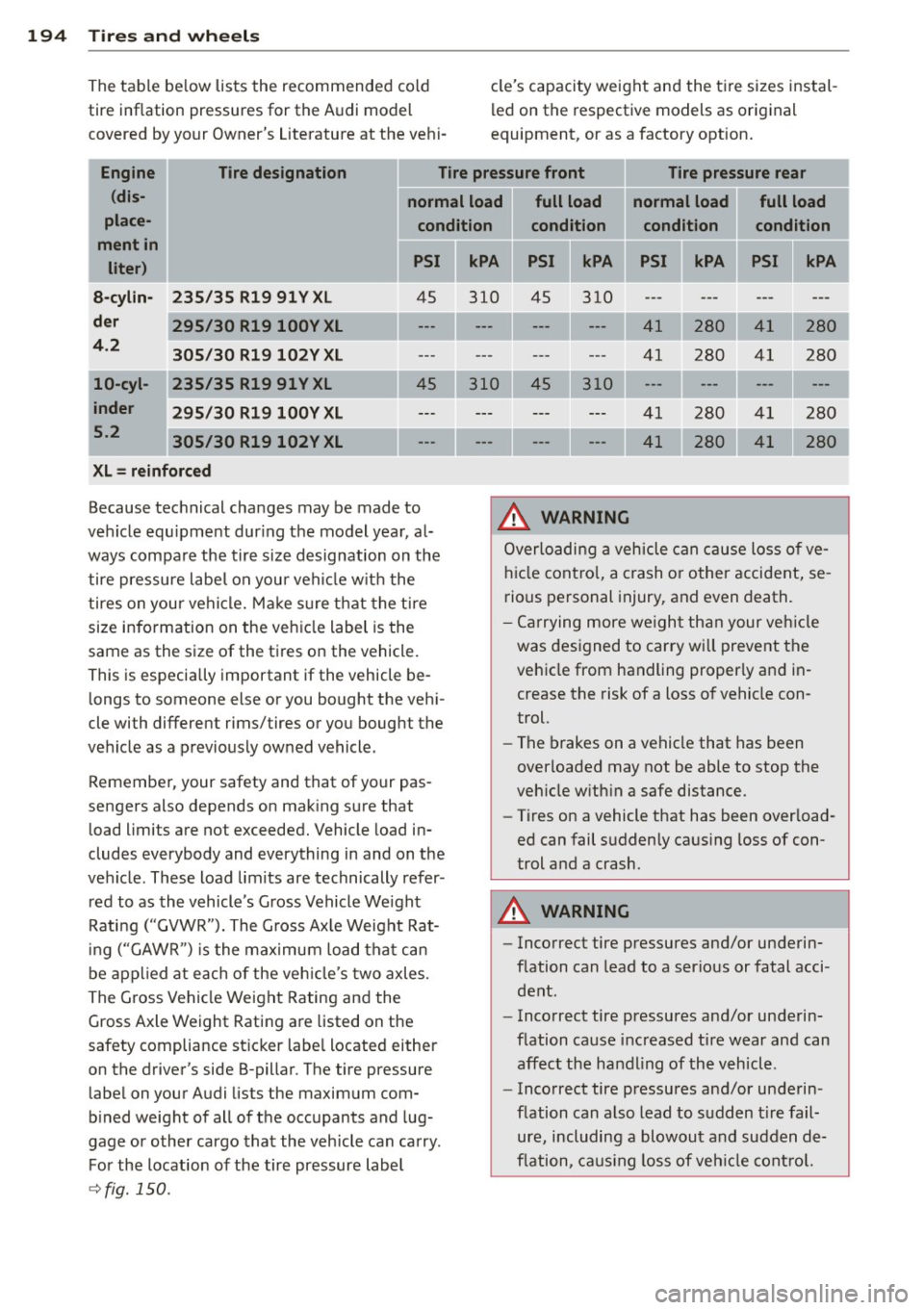
194 Tire s and wheel s
The table be low lists the recommended cold
tire inflation pressures for the Audi model
covered by your Owner's Literature at the vehi- cle's capacity weight and the tire sizes instal
led on the respective models as original
equipment, or as a factory option.
Engine
(dis
place
ment in Tire designation
Tire pressure front Tire pressure rear
normal load full load normal load full load condition condition condition condition
liter )
a -cylin
der
4 .2
inder
5.2 235
/3 5 R1 9 9 1 V
XL
295 /30 R19 100V X L
305 /30 R1 9 10 2V X L
235 /35 R19 91 V X L
295 /30 R1 9 100V XL
305 /30 R19 102V X L
XL= reinf orc ed
PSI
45
Because tec hnical changes may be made to
vehicle equ ipment dur ing the model yea r, a l
ways compare the tire size designation on the
tire pressure labe l on you r vehi cle w it h the
tires on your vehicle. Make s ure that the ti re
size information on the veh icle label is the
same as the size of the tires on the vehicle.
This is especially important if the vehicle be
longs to someone else or you bought the vehi
cle with different rims/tires or you bought the
vehicle as a previously owned vehicle.
Remember, your safety and that of your pas
sengers also depends on mak ing sure that
load limits are not exceeded. Vehicle load in
cludes everybody and everything in and on the
veh icle . These load lim its are technically refer
red to as the vehicle's G ross Vehicle We ight
Rati ng ("GVWR"). The G ross Ax le Weight Rat
i ng ("GAWR") is the max imum load that can
be app lied at each o f the veh icle's two axles.
The G ross Vehicle Weight Rating and the
Gross Axle Weight Rating are listed on the
safety compliance stic ker labe l located either
on the driver's side B-pillar. The tire pressure
labe l on your Audi lists the maximum com
b ined weight of all of the occupants and lug
gage or other cargo that the veh icle can carry.
For the location of the tire pressure label
¢ fig. 15 0 .
kPA PSI kPA PSI
310 45 310
41
41
kPA PSI
280 41
280 41
kPA
280
280
280
280
.&_ WARNING
Overloading a vehicle can cause loss of ve
h icle cont ro l, a crash o r other accident, se
r ious pe rsonal injury, and even death.
- Ca rrying more we igh t than your veh icle
was designed to carry wi ll prevent the
vehicle from handling properly and in
crease the risk of a loss of vehicle con
trol.
- The brakes on a vehicle that has been
overloaded may not be able to stop the
veh icle w ith in a safe distance.
- Tires on a vehicle that has been over load
ed can fail s uddenly ca us ing loss of con
trol and a crash.
.&_ WARNING
- Incorrect tire pressures and/or underin
flation can lead to a serious or fatal acci
dent.
- Inco rrect tire pressures and/or underin
f lation cause increased tire wear and can
affect the handling of the vehicle.
- Inco rrect tire pressures and/or underin
f lation can a lso lead to s udden t ire fail
ure, including a blowout and sudden de
flation, ca using loss of veh icle cont ro l.
Page 197 of 244
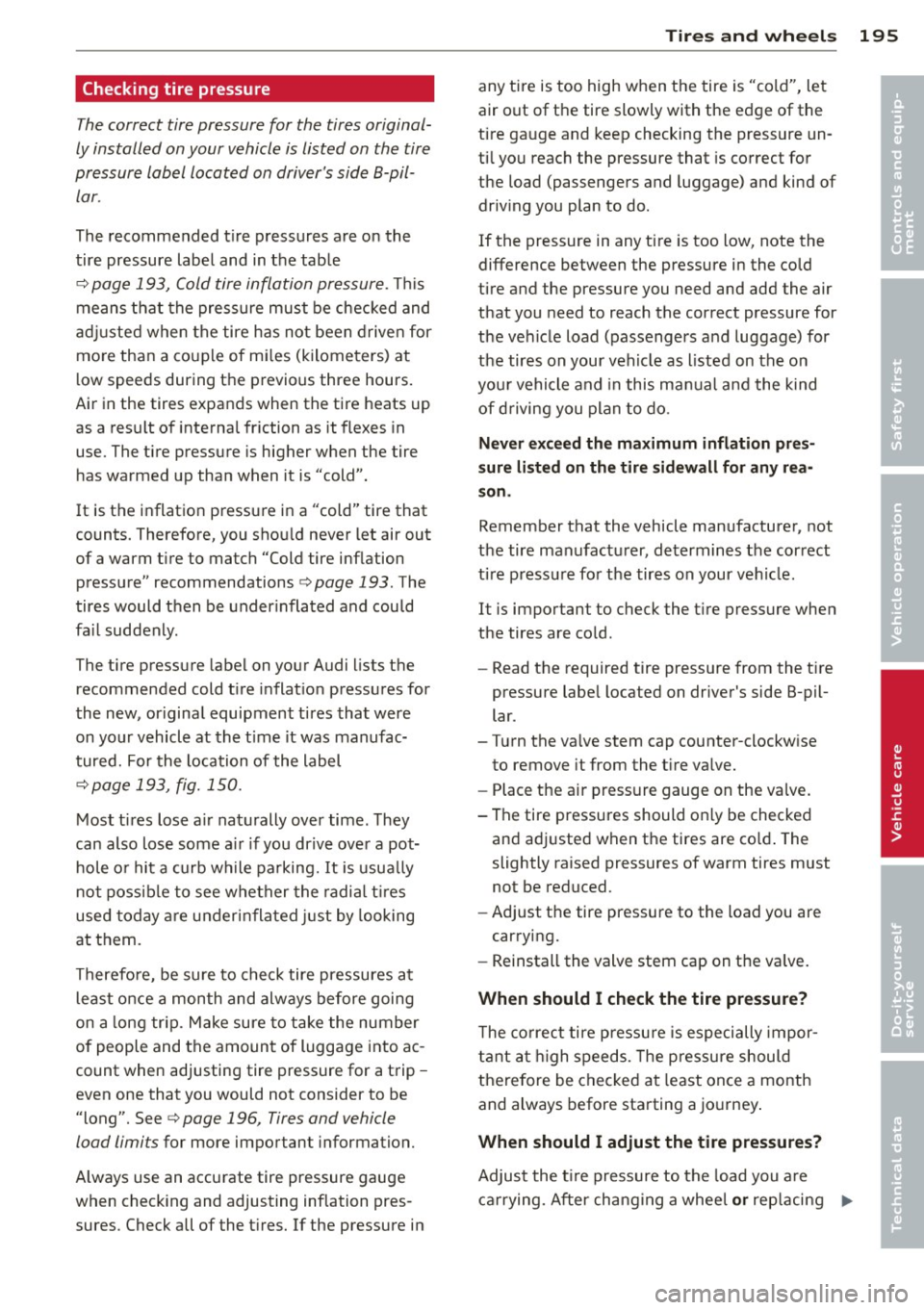
Checking tire pressure
The correct tire pressure for the tires original
ly installed on your vehicle is listed on the tire
pressure label located on driver's side 8-pil lar.
The recommended t ire pressures are on the
tire pressure label and in the table
r=> page 193, Cold tire inflation pressure . T his
means that the pressure must be checked and
a d ju sted when the tire has not been driven for
mo re than a couple of mi les (kilometers) at
l ow speeds during the p revious three hours.
Air in the tires expands when the tire heats up
as a result of internal fr iction as it flexes in
use. The tire pressure is higher when the tire
h as warmed up than when it is "cold".
It is the inflation pressure in a "cold" tire that
counts. Therefore, you shou ld never let air out
of a warm tire to match "Cold tire inflation pressure" recommendations
c> page 193 . The
tires would then be under infla ted and could
fa il suddenly.
The tire pressure label on yo ur Audi lists t he
recommended cold t ire inflat ion pressures for
the new, or igina l equipment tires that were
on you r vehicle at the t ime it was manufac
tured. For the location of the label
r=> page 193, fig. 150.
Most tires lose a ir natu rally over time. They
can also lose some a ir if you dr ive ove r a pot
hole o r hit a curb wh ile pa rking.
It is usua lly
not poss ib le to see whether the radial t ires
used today a re underin flated j ust by looking
at them.
Therefore, be sure to check tire pressures at
least o nce a month and always before going
on a long trip. Make sure to take the number
of people and the amount of luggage into ac
count when adjusting tire pressure for a trip -
even one that you would not consider to be
"long". See r:=>page 196, Tires and vehicle
load limits for more important information.
Always use an accurate tire pressure gauge
when check ing and adjusting inflation pres
sures . Check all of the t ires. If the pressure in
Tire s an d wheel s 195
any tire is too high when the tire is "cold", let
air out of the tire slowly with the edge of the
tire ga uge and keep checking the pressure un
ti l yo u reach the pressure that is correct for
the load (passengers and luggage) and kind of
driv ing you plan to do .
If the pressure in any ti re is too low, note the
difference between the pressure in the cold
tire and the pressure you need and add the air
that you need to reach the correct pressure for
t h e ve hicle load (passenge rs and luggage) for
t h e tires on your vehicle as l isted on the o n
you r vehicle and in this ma nual a nd the k ind
of d riving you plan to do .
Never exceed the max imum inflation pres
sure li sted on the tire sidewall for any rea
s on.
Remember that the vehicle manufacturer, not
t h e tire manufactu rer, determines t he cor rect
ti re p ressu re fo r the tires on your ve hicl e.
It is important to check the t ire pressure when
the tires are co ld .
- Read the required tire pressure from the t ire
pressure labe l located on driver's side B-pil
lar.
- T urn the va lve stem cap counter-clockw ise
to remove it from the tire va lve.
- Place t he air pressure gauge on the va lve.
- The tire pressures should o nly be checked
and ad justed when the tires are co ld . The
slightly raised pressures of warm tires must
not be reduced.
- Adj ust the tire pressure to the load you are
carrying.
- Reinstall the valve stem cap on the va lve.
When should I check the tire pr essu re?
T he co rrect tire pressu re is especially impor
t a nt a t high speeds. The pressure should
therefore be checked at least once a month
and always before starting a jo urney .
When should I adjust the tire pressures ?
Adjust the tire pressure to the load you a re
ca rrying. After chang ing a wheel
or rep lacing .,..
•
•
Page 198 of 244
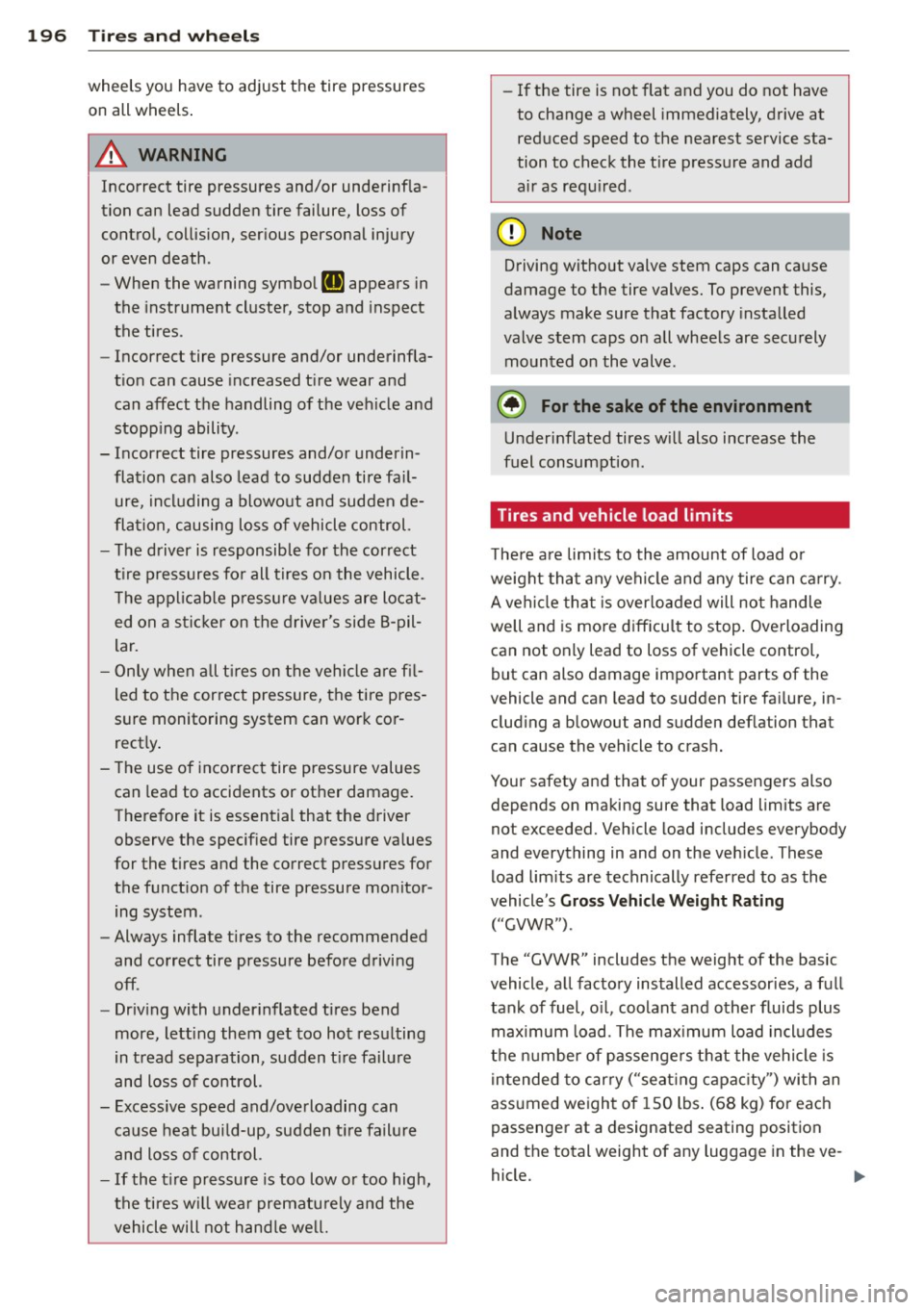
196 Tires and wheels
wheels you have to adjust the tire pressures
on all wheels.
A WARNING
Incorrect tire pressures and/or underinfla
tion can lead sudden tire failure, loss of
control, collision, serious personal injury
or even death.
- When the warning symbol
RI] appears in
the instrument cluster, stop and inspect
the tires .
- Incorrect tire pressure and/or underinfla
tion can cause increased tire wear and
can affect the handling of the vehicle and
stopping ability .
- Incorrect tire pressures and/or underin flation can also lead to sudden tire fail
ure, including a blowout and sudden de
flation, causing loss of vehicle control.
- The driver is responsible for the correct
tire pressures for all tires on the vehicle .
The applicable pressure values are locat
ed on a sticker on the driver's side 8-pil
lar.
- Only when all tires on the vehicle are fil
led to the correct pressure, the tire pres
sure monitoring system can work cor
rectly.
- The use of incorrect tire pressure values
can lead to accidents or other damage.
Therefore it is essential that the driver
observe the specified tire pressure values
for the tires and the correct pressures for
the function of the tire pressure monitor
ing system .
- Always inflate tires to the recommended
and correct tire pressure before driving
off .
- Driving with underinflated tires bend
more, letting them get too hot resulting
in tread separation, sudden tire failure
and loss of control.
- Excessive speed and/overloading can
cause heat build-up, sudden tire failure
and loss of control.
- If the tire pressure is too low or too high,
the tires will wear prematurely and the
vehicle will not handle well. -
If the tire is not flat and you do not have
to change a wheel immediately, drive at
reduced speed to the nearest service sta
tion to check the tire pressure and add
air as required .
(D Note
Driving without valve stem caps can cause
damage to the tire valves. To prevent this,
always make sure that factory installed
valve stem caps on all wheels are securely mounted on the valve.
@ For the sake of the environment
Underinflated tires will also increase the
fuel consumption .
Tires and vehicle load limits
There are limits to the amount of load or
weight that any vehicle and any tire can carry .
A vehicle that is overloaded will not handle
well and is more difficult to stop. Overloading
can not only lead to loss of vehicle control,
but can also damage important parts of the
vehicle and can lead to sudden tire failure, in cluding a blowout and sudden deflation that
can cause the vehicle to crash.
Your safety and that of your passengers also depends on making sure that load limits are
not exceeded. Vehicle load includes everybody
and everything in and on the vehicle . These
load limits are technically referred to as the
vehicle 's
Gross Vehicle Weight Rating
("GVWR").
The "GVWR" includes the weight of the basic
vehicle, all factory installed accessories, a full
tank of fuel, oil, coolant and other fluids plus
maximum load. The maximum load includes
the number of passengers that the vehicle is
intended to carry ("seating capacity") with an
assumed weight of 150 lbs. (68 kg) for each
passenger at a designated seating position
and the total weight of any luggage in the ve-
hicle. ..,_
Page 199 of 244
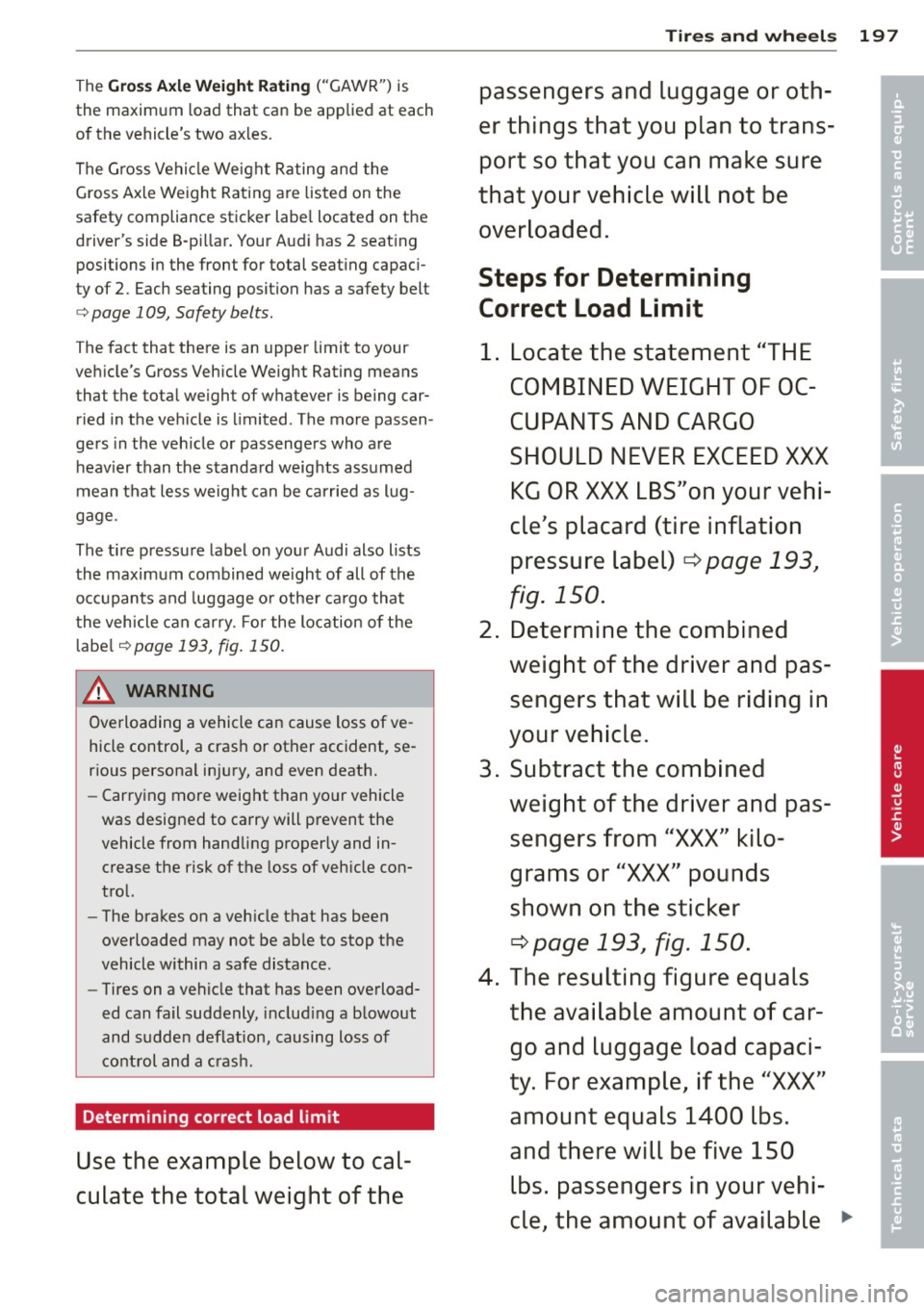
The Gross Axle Weight Rating ("GAWR") is
the maximum load that can be applied at each
of the vehicle's two axles.
The Gross Vehicle Weight Rating and the
Gross Axle Weight Rating are listed on the
safety compliance sticker labe l located on the
driver's side B-pi llar . Your Audi has 2 seat ing
positions in the front for total seat ing capac i
t y of 2. Each seating posi tion has a safety belt
c::> page 109, Safety belts.
The fact that there is an upper limit to your
ve hicle's Gross Veh icle Weight Rating means
that the total weight of whatever is being car
ried in the veh icle is limited . The more passen
gers in the veh icle or passengers who a re
heavier than the standard weights assumed
mean that less weight can be carried as lug
gage.
The t ire pressure label on your Audi also lists
the maximum combined we ight of all of the
occupants and luggage o r othe r cargo that
the vehicle can carry. For the location of the
la be l
c::>page 193, fig. 150.
A WARNING
Overloading a vehicle can cause loss of ve
hicle control, a crash or other accident, se
r ious personal injury, and even death.
- Carrying more weight than your vehicle
was designed to carry will prevent the
vehicle from handling properly and in
crease the risk of the loss of veh icle con
trol.
- The brakes on a veh icle that has been
overloaded may not be able to stop the
vehicle within a safe distance .
- Tires on a vehicle that has been overload
ed can fail suddenly, includ ing a b lowout
and sudden deflation, causing loss of
control and a crash.
Determining correct load limit
Use the example below to cal
culate the total weight of the
Tires and wheels 197
passengers and luggage or oth
er things that you plan to trans
port so that you can make sure
that your vehicle will not be
overloaded.
Steps for Determining
Correct Load Limit
1. Locate the statement "THE
COMBINED WEIGHT OF OC
CUPANTS AND CARGO
SHOULD NEVER EXCEED XXX
KG OR XXX LBS"on your vehi
cle's placard (tire inflation
pressure label)
¢ page 193,
fig. 150.
2. Determine the combined weight of the driver and pas
sengers that will be riding in
your vehicle.
3. Subtract the combined
weight of the driver and pas
sengers from
"XXX" kilo
grams or
"XXX" pounds
shown on the sticker
¢ page 193, fig. 150.
4. The resulting figure equals
the available amount of car
go and luggage load capaci-
ty. For example, if the
"XXX"
amount equals 1400 lbs.
and there will be five 150
lbs. passengers in your vehi
c le, the amount of available .,..
•
•
Page 200 of 244
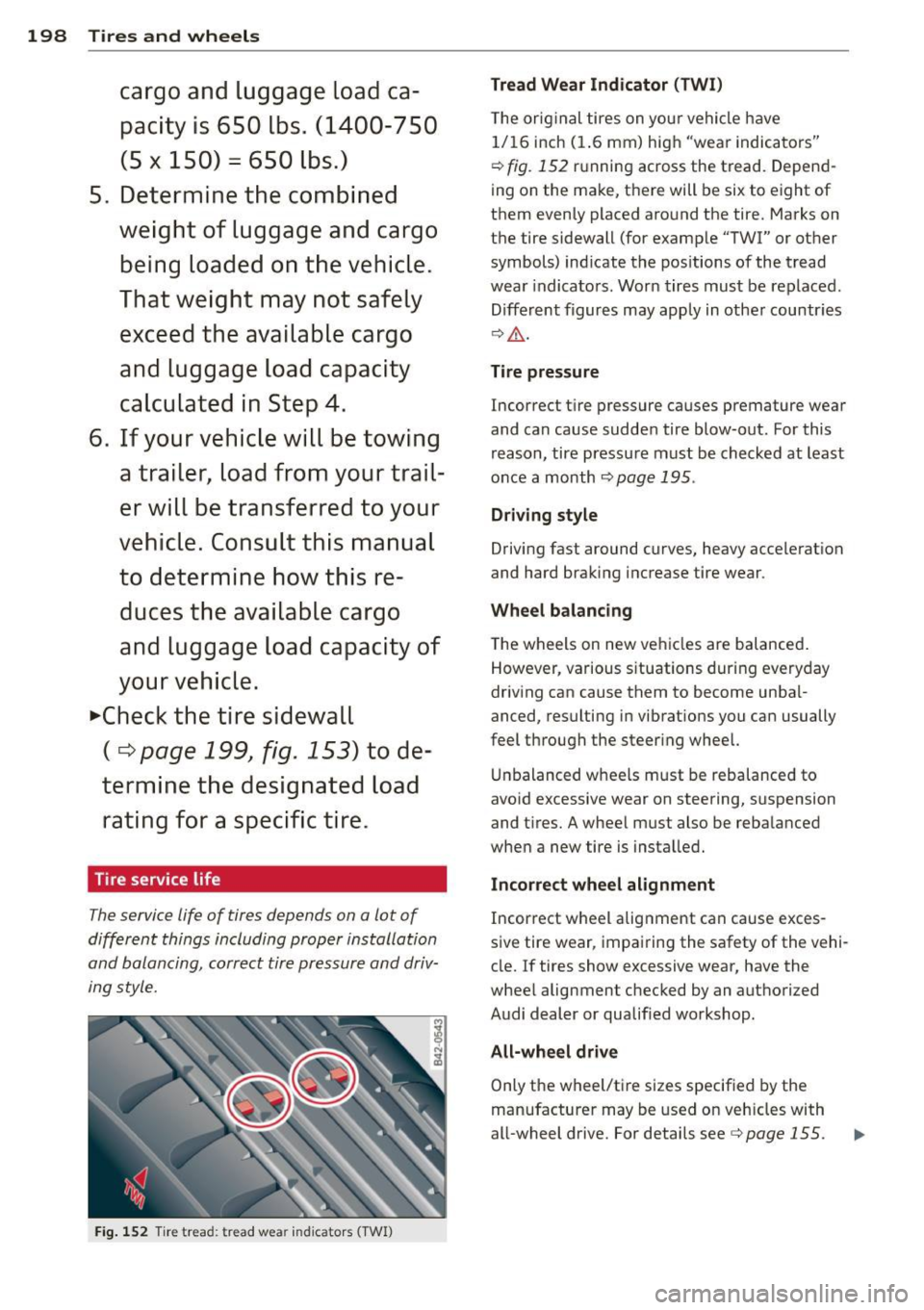
198 Tires and wheels
cargo and lugg age load ca
pacity is 650 lb s. (1400-750
(5
X 150) = 650 lb s.)
5. Determin e the combined
weight of luggage and cargo
being loaded on the vehicle .
That weight may not safely exceed the a vailable cargo
and luggage load capacity
c alculated in Step
4.
6. If your vehicle will be towing
a trailer , load from your trail
er w ill be tran sferred to your
vehi cle . Consult this manual
to determine how thi s re
duces the available cargo
and luggage load capacity of
your vehicle.
.,.Che ck the tire sidewall
( ¢ page 199 , fig. 153) to de
termine the designated load rating for a specific tire.
Tire service life
The service life of tires depends on a lot of
diff erent things i ncluding prop er installation
and balancing, correct tire pressure and driv ·
ing s tyle.
Fig. 152 T ire tread: trea d wea r ind icators (TWI)
Tread Wear Indicator (TWI)
The orig in al tires on yo ur vehi cle ha ve
1/ 16 inch ( 1.6 mm) hig h "wear indica tors"
¢ fig . 152 ru nning acro ss the tread . Depend·
ing on the ma ke , t here will be six to e ight of
them even ly placed aro und the tire. Marks on
t he tire sidewall (for example "TWI" or ot her
symbols) ind icate the pos itions of the tread
wea r indica to rs. Wor n tir es must be rep laced .
Differ ent figures may apply in othe r countries
¢ .&_ .
Tire pressure
Incor rect t ire pressure causes premature wea r
and can cause sudde n tire blow-out . For this
reason, tire pressu re must be checked at least
o nce a month
¢ page 195.
Driving style
Driving fast around c urves, heavy accele rat ion
and hard braking increase tire wear .
Wheel balancing
The wheels on new ve hicles are balance d.
However, va rious s ituations dur ing everyday
driv ing can cause them to become unbal·
anced, resulting in vib rations you can usually
feel t hrough the steer ing whee l.
Unb alanced w hee ls m ust be rebalance d to
avo id excessive wear on steering, suspension
and ti res. A whee l m ust also be reba lanced
whe n a new tire is insta lled.
Incorrect wheel alignment
Incor rect wheel alig nment can cause exces
s ive tire wear , impa iring the safety of the vehi
cle.
If tires show excessive wear , have the
w hee l alignment chec ked by an authoriz ed
Audi deal er or qualified wo rksh op.
All-wheel drive
Only the wheel/ti re sizes specif ied by the
manufacture r may be used on veh icles with
all-wheel drive. For detai ls see ¢
page 155.